The best way to protect a boat that is rubbing on pilings at the dock is with a fender board. A fender board is simply a piece of wood hung outside of two fenders which are hung off the side of a boat. The board rubs up and down on the pilings, and the fenders do not suffer abrasion from barnacles and oysters, since they are protected behind the board. As a boat moves about at the dock, a fender board will prevent the fenders from being out of position on the pilings. It does this simply by increasing the distance a boat must travel before the fenders no longer fall between piling and boat. Here is a diagram of the proper use of mooring lines and a set of fenderboards. That illustration shows how to tie the boat up, and where the fenders and board need to be located, but doesn't say how to actually put together a fender-board set.
Some boaters hang out a couple of fenders, and then hang the board to span the gap between the two fenders separately. Others tie the fenders to the board, then attach the whole arrangement to the boat using the lines from the board itself. The ones MacGregor Jim designed and built for us combine the two approaches, using a common line to tie the fenders to the board and to the boat. This fenderboard design is simple to make and deploy, having only two lines to handle. Instead of a piece of wood, which will be fairly heavy, we use a piece of PVC pipe as the "board" part of the fender board design.

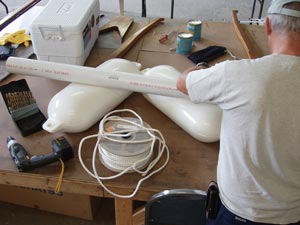
Tools and Materials Needed
The materials and tools needed are shown at left:
- Some three strand twisted nylon dock line
- A couple of 10" x 30" Taylor fenders
- A 5 foot section of 3" schedule 40 PVC pipe
- A drill and some drill bits
Update: With feedback from the good folks at the Cape Dory forum, I realized that I should mention that for boats up to about 25 feet in length, 2" schedule 40 PVC pipe and smaller fenders would work. For boats above 35 feet, I would use 4" schedule 40 pipe and larger fenders.
I also realized that a large enough PVC pipe could actually be used to store deflated fenders when not in use, but I have not investigated the practicality of that idea.

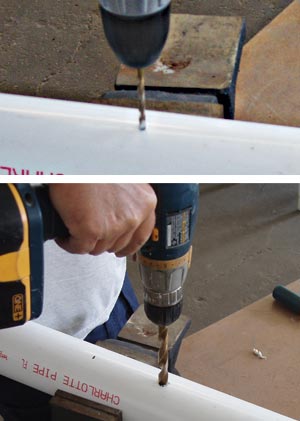
Step 1: Get Out Your Drill and Make Some Holes
We started by drilling two holes through the PVC pipe, each 16 inches from the end of the pipe. The holes need to be large enough for the dock line to pass through easily, and the edges of each hole should be rounded down a bit with sandpaper after drilling, to prevent chafing the dock lines.
It is easier to start out by drilling a smaller hole as a pilot, then drill the large hole for the line, as seen in the accompanying photos.

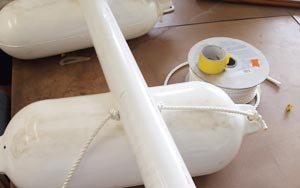
Step 2: Tie the Fenders to the Fenderboard
Once the holes are drilled in our new fender board, the hard work is done. I just love projects where the hard part consists of drilling two holes. Next, pass the dock line through the PVC pipe fender board. A knot on each side of the pipe will prevent the line from sliding.
The bottom length of rope should be just long enough to attach to the bottom of the fender. The upper section of line should be long enough to attach to the top of the fender, and then to reach the required distance up to the lifeline or other attachment point on the boat.
This picture shows how the line should be run through the PVC fender board and then tied to the bottom end of the fender, with two knots on either side of the PVC to ensure the line will stay in the same spot.

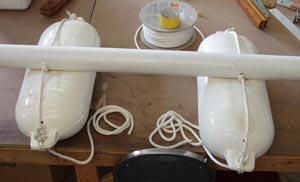
Your New Fenderboard Set
This photo shows the completed new fenderboard set. As you can see, the lines are tied off at the top of the fender, passed through the board with retaining knots, then tied to the bottom of the fender. The extra line at the top is used to hang the whole contraption from the boat.

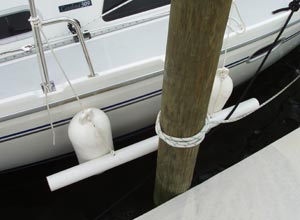 The new fenderboard set hanging on a Catalina 309
The new fenderboard set hanging on a Catalina 309The Fenderboard in Use
As the photo shows, the boat can move fore and aft a couple of feet before the fender board will fall off the piling. The fenders protect the boat, and the PVC fenderboard protects the fenders.
If those pilings were covered with oysters and barnacles, the PVC pipe would take the punishment, not the fenders themselves. Fenders are pretty tough, but oysters are very sharp — and eventually sharp wins.
Ordinary fenders can't take rubbing on sharp oysters and barnacles for very long, and they are expensive. PVC pipe can take quite a bit of that kind of abrasion, and is cheap and easy to replace.
PVC works better than a pressure-treated 2x4 or 2x6, also commonly used to make wood bumper boards, because the round pipe will not hang up as easily on piling bolts or marine growth as it slides up and down the piling. The corners of wood can catch, but a round pipe has no corners.
Feel free to adopt MacGregor Jim's design and copy this type of fender board. You will find that it is easy and inexpensive to build, and it works very well to protect your boat, as well as your expensive fenders. It's also easy to disassemble, if you need to stow it away for periods of time.
Leave a Reply
You must be logged in to post a comment.